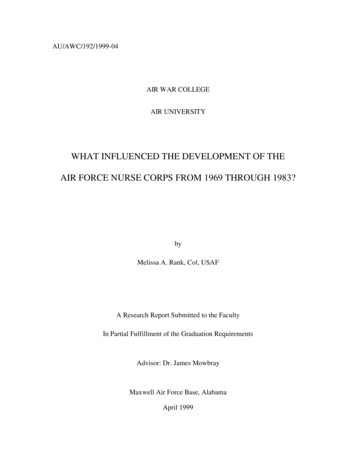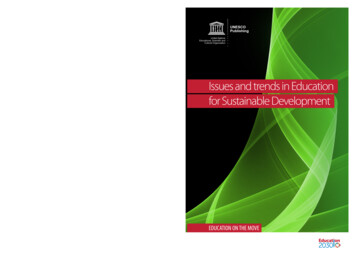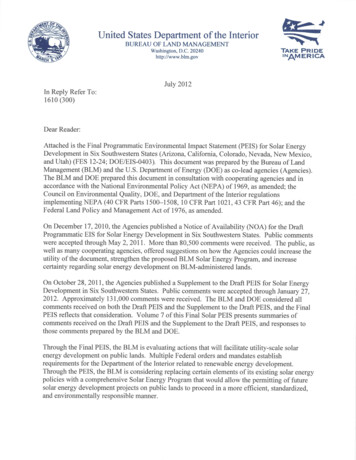
Transcription
AU/AWC/192/1999-04AIR WAR COLLEGEAIR UNIVERSITYWHAT INFLUENCED THE DEVELOPMENT OF THEAIR FORCE NURSE CORPS FROM 1969 THROUGH 1983?byMelissa A. Rank, Col, USAFA Research Report Submitted to the FacultyIn Partial Fulfillment of the Graduation RequirementsAdvisor: Dr. James MowbrayMaxwell Air Force Base, AlabamaApril 1999
DisclaimerThe views expressed in this academic research paper are those of the author(s) anddo not reflect the official policy or position of the US government or the Department ofDefense. In accordance with Air Force Instruction 51-303, it is not copyrighted, but is theproperty of the United States government.ii
ContentsPageDISCLAIMER. iiABSTRACT . ivINTRODUCTION. 1INFLUENCE OF THE EVOLUTION OF NURSE PRACTITIONERPROGRAMS ON THE AIR FORCE NURSE CORPS AND THE AIRFORCE MEDICAL SERVICE . 1OB/GYN Nurse Practitioners. 1Pediatric Nurse Practitioners. 3Midwives. 5Certified Registered Nurse Anesthetists . 7Primary Care Nurse Practitioner . 8Trends Identified . 10INFLUENCE OF THE AIR RESERVE COMPONENTS ON THE CREATIONOF THE TOTAL NURSING FORCE . 12Total Nursing Force . 12Total Nursing Force Milestones. 13INFLUENCE OF BACCALAUREATE NURSING PROGRAM EDUCATIONAND THE NEED FOR A NURSE INTERNSHIP PROGRAM FOR NEWOFFICER ACCESSIONS . 20Nurse Internship Program . 20CONCLUSIONS . 24APPENDIX A: A CHRONOLOGY OF AMERICAN AIR FORCE NURSING. 27Objectives of the nurse corps career development program* . 45APPENDIX B: LIST OF REFERENCES FOR APPENDIX A. 59BIBLIOGRAPHY . 63iii
AU/AWC/192/1999-04AbstractThe purpose of this work is first, to seek out and record events in the history ofmilitary nursing that influenced and shaped the Air Force Nurse Corps from January 1969through December 1983. A second endeavor of this research is to identify factors thatinfluenced the professional and career development of Air Force nurses. The AnnualReports of the Surgeon General were used to compile a chronology of events from 1969to 1983. An analysis of the chronology revealed at least three important factors influencedthe development of opportunities for Air Force nurses during this time frame: theevolution of nurse practitioner programs that expanded the skills and abilities of nurses,the adoption of the total force concept within the Air Force Medical Service and nursing’srole in embracing the Air Reserve Components, and the creation of a nurse internshipprogram to ease the transition of initial active duty nurses into the Air Force. Thischronology is another step toward development of a complete and relevant Air ForceNursing history.iv
Chapter 1IntroductionThe purpose of this work is to seek out and record events in the history of militarynursing that influenced and shaped the Air Force Nurse Corps from January 1969 throughDecember 1983. The time frame was selected to cover the terms of the fifth, sixth andpart of the tenure of the seventh Air Force Chief Nurses.This inquiry into military nursing is the middle segment of a larger research piecedeveloped in collaboration with two other Air War College nurses. Colonel Jill Baker,nurse graduate of AWC in 1998, captured the history of military nursing from 1947through December 1968 while Lt Col Kerrie Lindberg, AWC student of the class of 1999,explored the history of Air Force nursing from 1984 to the present.A database was created to capture the highlights of the Air Force Nurse Corps historyin one concise document (Appendix A). It is a chronological timeline constructed byextracting data from files in the Office of the Surgeon General, mostly Annual Reports,located in the Historical Research Agency at Maxwell Air Force Base, Alabama. Thecriterion for inclusion in the database was to answer the question; “Does this event seemto be relevant to the history of the Air Force Nurse Corps?” Since this is a pivotal steptoward writing the Air Force Nurse Corps history, if the answer was maybe, the event wasincluded.1
The second purpose was to look for trends in the data and answer the question“What influenced the professional and career development of nurses in the Air Force?”Although there were many influences, three important trends emerged.The first was the influence of a physician shortage and the creation of nursepractitioner roles to overcome this shortage.The second trend transpired with the adoption of the total force concept within theAir Force Medical Service and nursing’s role in embracing the Air Force ReserveComponents and capitalizing on the unique roles and capabilities of Guard and Reservenurses to meet the mission of the United States Air Force.The third trend surrounded the need to create a nurse internship program to ease thetransition of initial active duty nurses into the Air Force, bolster their nursing skills, andenhance their leadership abilities.2
Chapter 2Influence of the Evolution of Nurse Practitioner Programs onthe Air Force Nurse Corps and the Air Force Medical ServiceOB/GYN Nurse PractitionersAs a result of the mandatory cancer detection program for women in the Air Force inMarch 1969, a pilot project was started for the training and utilization of United StatesAir Force Gynecology (GYN) nurse clinicians. Two Air Force Nurses attended a courseat the University of Kansas Medical Center, Kansas City, Kansas, in March 1969 underthe direction of Dr. Kermit Krantz, one of the Obstetric-Gynecological (OB/GYN)consultants for the United States Air Force Surgeon General.(1:457) By February 1971,four Air Force nurses had received training. Besides these four nurses, other Air Forcenurses were trained on-the-job or in other special courses.(2:192) By November 1971,these nurses greatly increased the service to the community and more efficient utilizationof the OB/GYN physician had occurred. These nurses were believed to be able to carry apatient load of approximately 500 patients a month. They would perform cancerprevention, family planning, minor GYN procedures, and premarital education. (3:12)In 1972, as the Air Force entered the zero draft environment, an even greater shortageof physicians was anticipated. In preparation, Air Force nurses expanded their roles toassume those responsibilities currently being accomplished by physicians that nurses1
glyenough,Obstetrical/Gynecological (OB/GYN) Nurse Practitioners had been physician extendersin cancer detection clinics since 1968. Their roles were expanded in 1972 to includefamily planning, prenatal and GYN screening services. (4:2)The years of 1973 through 1974 were banner years for OB/GYN Nurse Practitioners.As of 30 June 73, there were 75 nurses practicing as OB/GYN Nurse Practitioners(9756A) throughout the Air Force. (5:153) By November 1973, certification procedureswere initiated to assess whether these nurses were professionally qualified as OB/GYNpractitioners. (6:137) As 1974 unfolded, the United States Air Force OB/GYNpractitioner course was established at the School of Health Care Sciences (SHCS). Sixstudents entered the four-month OB/GYN Nurse Practitioner Course. (7:124) By theclose of this same year, there were 126 OB/GYN Nurse Practitioners assigned. Eightyfour of the OB/GYN Nurse Practitioners were United States Air Force certified. Allothers were graduates of approved programs gaining the required experience to apply forcertification. (8:122-123)In the Pacific Air Forces (PACAF) during the year of 1974 and 1975, OB/GYNNurse Practitioners demonstrated their worth. OB-GYN Nurse Practitioners at Misawa,Tachikawa, Kadena, Clark, Hickam and Osan saw a total of 23,638 patients during theyear. Quarterly consultant visits were made by the nurse practitioner at Clark to theThailand bases and by the nurse practitioner at Osan to Kunsan Air Base. This practiceproved extremely helpful in meeting the medical needs of female personnel in the moreremote areas. Utilization of Primary Care Nurse Practitioners was expanded throughoutthe command with nurses serving effectively in this role at 14 medical facilities.2
Guidance and proper utilization of and required physician support for these health careextenders was discussed with each Director, Base Medical Services (DBMS) and ChiefNurse. (9:7)Pediatric Nurse PractitionersBrigadier General Ethel A. Hoefly provided insight into the evolution of the PediatricNurse Practitioner program during her tenure as Chief Nurse. This role expanded theskills and responsibilities of nurses and was created to assist with the Air Force’sphysician shortage. These nurses conducted well baby clinics at military treatmentfacilities where physicians were not assigned. The parents were very responsive,comfortable and less hesitant to ask the nurses questions about baby care. Most familieswere reluctant to take up the physicians time and were fearful their questions might bedumb or silly. The physician staff was very supportive of the Pediatric Nurse Practitionerprogram. (10:38-71)The pilot course for the Pediatric Nurse Practitioner (PNP) was initiated in August1970 for three nurses per class for four months at Wilford Hall United States Air ForceMedical Center, Lackland Air Force Base, Texas. The course was offered twice annually.This course trained nurses in well baby care and minor illnesses of children.(11:199)(2:193)By January 1971, Air Training Command (ATC) had developed a training programat six of its bases for a “Pediatric Nurse Associate” who worked alongside a physicianpreceptor. This was a four-month program and was comprised of one-week in residenceat United States Air Force Hospital Sheppard and fifteen weeks of training with a3
preceptor pediatrician at a base of assignment. The second group of three nurses beganthe Pediatric Nurse Practitioner Course on 22 March 1971.Another group of AirTraining Command (ATC) nurses (7 or 8) began in the second training course at ATCbases on 4 October 1971. (7:193)(2:193)During the years of 1973 and 1974, the PNP Program “came into its own.” By 30June 73, there were 57 nurses practicing as Pediatric Nurse Practitioner’s (9756B)throughout the Air Force. (5:153) By November 1973, certification procedures wereinitiated to assess whether nurses were professionally qualified as Pediatric NursePractitioners (PNPs). (6:137) In Fiscal Year 1974, seven Air Force nurses entered a 16week continuing education program at the University of Virginia for PNPs in May. AirForce nurses were programmed for PNP training at the University of Virginia; Universityof Rochester, New York; Good Samaritan Hospital, Phoenix, Arizona; and MethodistHospital, Indianapolis, IN. (5:153)In 1974, a PNP courses was established at theSchool of Health Care Sciences (SHCS). Ten students entered the four-month PNPCourse. (7:1) And, by the close of 1974, there were 107 Pediatric Nurse Practitionersassigned. Seventy-four were USAF certified. All others were graduates of approvedprograms who gained the required experience to apply for certification. (8:1) Resoundingevidence of their hard work and irrefutable benefit to the Air Force Medical Service wasseen in the Pacific Air Force in 1974 and 1975, where PNPs assigned to four PACAFmedical facilities saw a total of 19,042 patients during that year. (9:7)In 1983, the Pediatric Nurse Practitioner (PNP) course was reactivated to fillprojected losses with 10 nurses selected to participate. (12:10).4
MidwivesOn 13 November 1970, a letter was prepared by Major General Thomas H. Crouch,Deputy Surgeon General who felt the Air Force Medical Service (AFMS) was in an idealsituation to utilize midwives, not to do home deliveries alone in the slums, but to handlenormal deliveries in nice hospitals as a staff member under the general supervision of achief-of-service. This had obvious advantages for the Air Force Medical Service (AFMS).It meant more gynecological could be done without more doctors and these nurses couldcarry the present load with fewer physicians. It opened up the AFMS, to an entirely newgroup for recruitment of personnel.Major General Crouch showcased the nurse anesthetist program as an excellentexample of nurses who are doing what was previously required by a doctor. The muchwider use of nurse clinicians at this level of responsibility offered a way to compensatefor the reduction of physicians which looked to be inevitable for the Air Force MedicalService.With these things in mind, Major General Crouch, explored the feasibility of trying anurse-obstetrician at Langley AFB Hospital. If successful, it would become possible forTactical Air Command (TAC) to utilize up to 22 midwives and reduce about 10, maybemore, medical officers. If such a program could be started at a few bases, the AFMScould recruit nurses for it. If nurses could be recruited, then the program could beexpanded proportionally. (3:1)In December 1970, the proposal to utilize a qualified midwife as a nurse midwife atUnited States Air Force Regional Hospital Langley Air Force Base, VA was approved bythe Surgeon General. Capt G. B. Ryder reported in February 1971.(3:3)(13:191) Her5
responsibilities included: improving medical services to gynecological patients, relievingmedical officers to care for patients with more complex problems, acting as an effectivescreening agent for the physician in detecting abnormalities and improving utilization,morale and retention of professional nurses. (3:8)By Nov 1971, Major Gen Crouch submitted a request to defer any program toinformally train Air Force nurse midwives. He felt the need for midwives in the AirForce had been recognized, however, formal training by the Air Force was underway andadditional steps had been taken to identify and formally train additional candidates.(3:13)On 24 Mar 72,Brigadier General Hamilton B. Webb, Tactical Air CommandSurgeon General suggested to the Air Force Surgeon General (SG) that it may be easierand quicker to contract with a medical school to teach Midwifery in AFMS hospitalsrather than to establish Air Force Medical Service teaching programs. (3:14)By March 1973, the Nurse-Midwife Residency Program was established. The firstclass of six nurses trained at Malcolm Grow United States Air Force Medical Center,Andrews Air Force Base, Maryland. (14:153)In November 1973, the first nurse-midwives completed their residency studies at Malcolm Grow USAF Medical Center andtook their certifying examinations through the American College of Nurse-Midwives(ACNM). An on-site evaluation of the Air Force Nurse-Midwifery residency programwas made by ACNM to determine eligibility for accreditation.(6:137)In 1974, twenty-eight Nurse Midwives were working in their specialty at selected AirForce hospitals.Five nurses were in Air Force Institute of Technology sponsoredmasters’ programs leading to certification in Nurse Midwifery. (8:1) In 1975, the Nurse6
Midwifery Residency established an affiliation with Georgetown University and receivedfull accreditation for the program from the American College of Nurse Midwives.(15:125-126)General Ethel A. Hoefly, Chief of the Nurse Corps, when the nurse midwiferyprogram stood up, reflected on how nicely this program evolved during her oral interviewon 13 May 78. This program was developed due to a shortage of obstetricians and themidwifery program was highly successful. (10:38-71)Certified Registered Nurse AnesthetistsThe nurse anesthetist program is an excellent example of nurses who were doingwhat was previously required by a doctor. One of the primary reasons this practitionerwas created was to compensate for the lack of physicians available to care for patientsduring the Vietnam Conflict. During this conflict, the worth of the Certified RegisteredNurse Anesthetist (CRNA) cannot be emphasized enough. These Certified RegisteredNurse Anesthetists (CRNAs) provided a critical wartime skill. Thus, the much wider useof nurse clinicians at this level of responsibility occurred because of the great success ofCRNAs who blazed the path for other practitioners to follow. (3:1)In 1973, a projected shortage of 29 nurse anesthetists was alleviated with thefollowing actions:1.2.3.4.Deferred two nurse anesthetists selected to attend Air Command and StaffCollege in August until the following year.Removed four nurse anesthetists selected as alternate for AFIT programsfrom the alternate roster.Requested 13 selected nurse anesthetists with dates of separation duringCalendar Year (CY) 73 to extend. Three extended.Tasked Headquarters Recruiting Service with an urgent requirement fornurse anesthetists.7
5.6.7.Increased the military consultants to the Surgeon General for nurseanesthesia from three to eight.Approved a nurse anesthetist procurement package sponsoring 10 civiliannurses in their last year of anesthesia training.Recalled three reserve nurse anesthetists volunteers to extended activeduty. (5:154)In April 1982, Brigadier General Sarah P. Wells, Chief, Air Force Nurse Corps,chaired a one-day meeting at Bolling Air Force Base to discuss and evaluate nurseeducation programs and policies. (16:4) The availability of adequate number of nurseanesthetists to meet increasing requirements was also discussed. One of the first issueson the table, was alternatives for training additional nurse anesthetists and plans wereestablished for a senior sponsorship program for these students was begun. (16:4-7)Primary Care Nurse PractitionerIn 1973, the utilization of Primary Care Nurse Practitioners was considered tomaintain patient care capacity with fewer physicians.(5:154)In Feb 1974, a United States Air Force Primary Care Nurse Practitioner (PCNP)program was established with the enrollment of twelve Air Force nurses in a six-monthcourse at the University of Arizona to spearhead plans for utilization of this new resource.Comparable educational experiences were being developed at the School of Health CareSciences so that an “in-house” capability for training Primary Care Nurse Practitioners(PCNPs) would be realized during Fiscal Year 75. (7:124)In October of the same year, twelve Air Force nurses graduated from the Universityof Arizona and were assigned to specific medical facilities for preceptorship. Twenty-oneAir Force nurses entered the first in-house PCNP course at the School of Health CareSciences. A second class was scheduled fo
This inquiry into military nursing is the middle segment of a larger research piece developed in collaboration with two other Air War College nurses. Colonel Jill Baker, nurse graduate of AWC in 1998, captured the history of military nursing from 1947 through December 1968 while Lt Col Kerrie Lin











